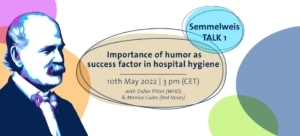I am sure that we can find “Semmelweis personalities” also today in the hospitals, says Noel Abela, Infection Control Nurse at Mater Dei Hospital – Malta. Carola Timmel interviewed him about the positive deviance approach in the occasion of May 5, the international hand hygiene day.
Mr. Abela, what does positive deviance generally means, and what does it mean in the context of hospital acquired infections?
I would like to start this interview with a short story about a character called Nasurudin. Nasurudin was a well-known smuggler and every day he used to reach the customs check point with a herd of donkeys. The custom officer knowing he was a smuggler he would check all the baskets to try and find something illegally. However the customer officer couldn’t’t find anything wrong with Nasurudin merchandise and he had to let him pass the check point. The customer officer became frustrated over the years and finally both of them retired and they met in a coffee shop. The retired customer officer asked Nasurudin what was he smuggling and the answer was ‘Donkeys’.
Nasurudin story holds a very important lesson that very common the solutions to many intractable problems are invisible to our eyes and positive deviance approach will help to make the invisible intractable problems visible.
The Positive Deviance approach assumes that every community has individuals or groups whose uncommon behaviours and strategies enable them to find better solutions to problems than their peers although everyone has access to the same resources and challenges (Pascale, Sternin, & Sternin 2010).
When it comes to healthcare associated infections we all know what to do i.e. Hand hygiene, environmental cleaning, standard precautions, surveillance and practice the infection control bundles. Positive deviance approach will help to identify the positive deviants in healthcare and sharing their best practices. This results in “social immune response” in the same way that our body triggers an immune defense response. In other words we need a behavioral change.
Positive deviance is focusing on practice rather than on knowledge – would it be desirable that the experiences of health care workers (HCW) are more included in future hygiene-strategies?
Positive deviance is a bottom to top approach, where the frontline healthcare workers they do and decide how to do it, the middle management support the ideas and the leadership make it happen. Unfortunately in healthcare we tend to go for the top to bottom approach where the leadership decides and the frontline carry out the decisions taken by the leadership. The latter approach will not work as we need to listen to the frontline people as they are the ones who are working directly with the patients. When it comes for example to hand hygiene campaigns, I highly believe that if we are planning to do a hand hygiene campaign we need to involve the frontline to get the most effective ideas so that in the end we will have an effective campaign and most important ownership as Lao-Tse (in: Tao Te Ching) said once Learn from the people – Plan with the people – Begin with what they have – Build on what they know – Of the best leaders – When the task is accomplished -The people all remark – We have done it ourselves
In your lecture (at the Semmelweis Conference) you mentioned that Semmelweis was a positive deviant. I am sure that we can find this “Semmelweis personalities” also today in the hospitals, and I could imagine that it’s not easy for them. How do you encourage colleges to become a positive deviant?
First of all one has to identify these positive deviants. They can be identified through discovery and action dialogues (DAD). Typical questions are for example: What do you do to prevent spreading MRSA to other patients or staff or what prevents you from doing these things all the time?
Can you give me a best practice example?
If we look at the success story at the Billings Clinic in Montana, USA, once they introduced the concept of positive deviance in May 2006 to reduce the healthcare associated MRSA infections, by December 2008 there was an 84% reduction in Healthcare associated MRSA infections.
This number speaks for itself: If everything has failed in your hospital or institution to reduce healthcare associated infections, positive deviance approach could be the solution in your hospital/clinic or nursing home.




